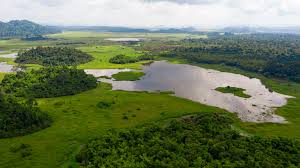
Cat Tien National Park (belongs to Dong Nai Biosphere Reserve) – Photo on http://cattiennationalpark.com.vn/
Dong Nai Biosphere Reserve in the provinces of Dong Nai, Binh Phuoc, Lam Dong and Dak Lak was recognized on November 10, 2001 with a total area of 728,756 hectares; Population: about 170,500 people; After expanding the core area and changing its name to Dong Nai Biosphere Reserve, it was recognized by UNESCO on June 28, 2011 with 969,993 hectares; Population: about 170,500 people.
Dong Nai Biosphere Reserve spreads across the provinces: Dong Nai, Lam Dong, Binh Duong, Binh Phuoc and Dak Nong. In there:
– Core area: 172,502 hectares, including: Cat Tien National Park: 72,208 hectares and Dong Nai Culture and Nature Reserve: 100,294 hectares.
– Buffer zone: 349,995 hectares.
– Transition area: 447,496 hectares.
This is the last remaining tropical humid rain forest area in the South of our country, with many rare plant and animal species that are threatened with extinction. The ecosystems here are extremely important with the function of regulating water in the upstream of Dong Nai River, providing fresh water in the dry season and controlling flooding in the rainy season for a large region of the Southeast region, including Ho Chi Minh City including export processing zones, industrial parks, residential areas…
The biosphere has more than 13 ethnic groups living, including: Kinh people (plains, lowlands), S’Teng people and Chau Ma, Chau Ro people have settled here for several centuries alongside other ethnic groups. Few new people moved in from the North such as Tay, Nung, Dao, Hoa, H’Mong… During the resistance war. This is the revolutionary base “War Zone D” with the indomitable heroic tradition of the forests of the Southeast region, making an important contribution to the nation’s glorious victory.
The biosphere area includes Cat Tien National Park, Dong Nai Nature and Culture Reserve, and Bau Sau Ramsar Site. Dong Nai Biosphere Reserve is a model of multi-purpose conservation, this will be a model of sustainable development, harmony between people and nature based on biodiversity and cultural diversity maintained since ancient times. . Traditional customs and practices are preserved in association with biodiversity conservation. This model promises prospects for conservation work from the perspective of “Conservation for development, development for conservation”.
Source: Department of Natural Resources and Biodiversity



